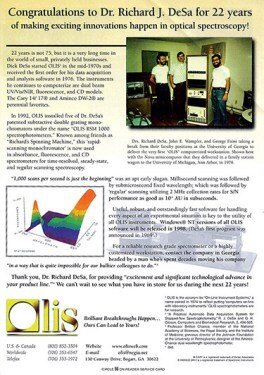A Biased View of Uv/vis/nir
Wiki Article
All About Uv/vis/nir
Table of ContentsThe smart Trick of Uv/vis That Nobody is Talking AboutCircular Dichroism Can Be Fun For AnyoneUv/vis Can Be Fun For EveryoneUv/vis/nir for BeginnersSpectrophotometers Can Be Fun For Anyone

Spectrophotometry is a tool that hinges on the quantitative analysis of particles depending on how much light is taken in by colored substances.
See This Report about Circular Dichroism
A spectrophotometer is frequently utilized for the measurement of transmittance or reflectance of options, transparent or nontransparent solids, such as sleek glass, or gases. Numerous biochemicals are colored, as in, they take in visible light and therefore can be measured by colorimetric treatments, even colorless biochemicals can typically be transformed to colored compounds suitable for chromogenic color-forming responses to yield substances appropriate for colorimetric analysis.: 65 Nevertheless, they can likewise be designed to determine the diffusivity on any of the noted light varieties that usually cover around 2002500 nm using different controls and calibrations.An example of an experiment in which spectrophotometry is used is the decision of the balance constant of an option. A particular chain reaction within an option might happen in a forward and reverse instructions, where reactants form products and products break down into reactants. At some time, this chemical response will reach a point of balance called a balance point.
Not known Factual Statements About Uv/vis/nir
The amount of light that goes through the solution is a sign of the concentration of specific chemicals that do not enable light to pass through. The absorption of light is because of the interaction of light with the electronic and vibrational modes of particles. Each type of particle has a specific set of energy levels connected with the makeup of its chemical bonds and nuclei and hence will soak up light of specific wavelengths, or energies, leading to unique spectral residential or commercial properties.
Making use of spectrophotometers spans different clinical fields, such as physics, materials science, chemistry, biochemistry. circularly polarized luminescence, chemical engineering, and molecular biology. They are extensively used in lots of markets including semiconductors, laser and optical my explanation manufacturing, printing and forensic evaluation, as well as in laboratories for the study of chemical substances. Spectrophotometry is frequently used in measurements of enzyme activities, determinations of protein concentrations, determinations of enzymatic kinetic constants, and measurements of ligand binding reactions.: 65 Eventually, a spectrophotometer has the ability to figure out, depending on the control or calibration, what compounds exist in a target and exactly just how much through calculations of observed wavelengths.
This would come as a solution to the previously developed spectrophotometers which were unable to absorb the ultraviolet correctly.
All about Circularly Polarized Luminescence
It would be discovered that this did not provide acceptable results, for that reason in Model B, there was a shift from a glass to a quartz prism which permitted for better absorbance results - UV/Vis (https://www.4shared.com/u/FvsNFVfH/julieanndesalorenz30606.html). From there, Design C was born with an adjustment to the wavelength resolution which ended up having three units of it producedIt irradiates the sample with polychromatic light which the sample soaks up depending on its properties. Then it is transmitted back by grating the photodiode range which detects the wavelength area of the spectrum. Ever since, the development and implementation of spectrophotometry devices has increased exceptionally and has actually ended up being one of the most ingenious instruments of our time.

Some Of Uv/vis/nir
The grating can either be movable or fixed.In such systems, the grating is fixed and the strength of each wavelength of light is measured by a various detector in the variety. When making transmission measurements, the spectrophotometer quantitatively compares the fraction of light that passes through a reference option and a test service, then electronically compares the intensities of the 2 signals and computes the percentage of transmission of the sample compared to the recommendation requirement.

Report this wiki page